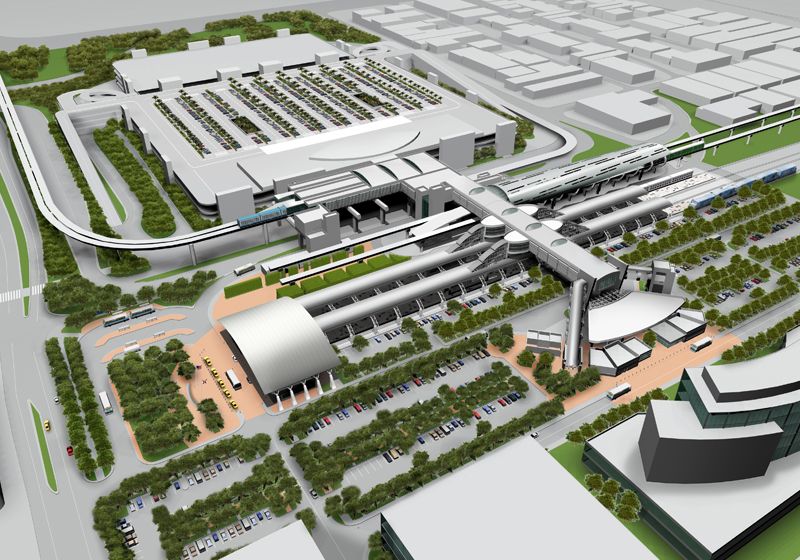Design of Intermodal Passenger Terminal
Contents |
[edit]  Introduction
Introduction
A multimodal passenger terminal is transportation centre in which several modes of transportation are physically and operationally integrated, usually under one roof.
At one terminal, complex vehicles arrive and depart while passengers interchange between the modes. Interchanges interconnect different transport modes that complement each other to accommodate a person’s journey from its origin to its destination. They are key public transport nodes. The function of the interchange is to reduce the distance between transport modes to facilitate multi-activities patterns.
The benefits of multimodal transport include time-saving, reduced waiting time, urban integration, reduced pollution, carbon emission, noise and congestions, and improvement of business operational models.
Multimodal passenger terminals can accommodate bus, rail, transit, taxi, automobile, ferry and aircraft modes. Mode integration can be achieved by methods such as coordinated schedules, joint use of services, and fare integration.Designing intermodal terminals is a multi-disciplinary task, the aim of which is to obtain maximum efficiency and enhance accessibility to all users.
Travel information and intermodal services are provided in all zones as well as in the facilities and retailing. The main design considerations are safety and security, transfer conditions, emergency planning, information, aesthetics, services and facilities, environmental quality, and comfort of waiting time.
The factors that influence the architecture of an interchange include; users, operators, third part deals with local impacts, governance and business models, mobility patterns, urban density and location of activities, technology, land use planning and social concerns.
The typologies of intermodal terminals depend on functions, logistics and spatial location (local constraints).
Demand – the volume of passengers define the size of the size of the terminal, the need for space and access characteristics. There are three levels of demand:
- Less than 30,000 passengers/day.
- Between 30,000 and 120,000 passengers/day.
- More than 120,000 passengers/ day.
Modes of transport include:
- Intermodal terminal with buses as the dominant mode of transport.
- Intermodal terminal with rail as the dominant mode of transport.
- Two or more public transport modes or different lines of the same mode jointly.
[edit] The physical components of intermodal terminals
The interchange will typically have three spatial zones:
- Access-egress zone - a zone in which links to the local area and access to transport modes are present.
- Facilities zones - a zone that comprises supporting services like retail shops, restaurants, ticketing, hotels etc.
- Arrival-departure - this caters for intermodal transfers.
[edit] The access-egress zone
This zone should provide facilities and services for users arriving and leaving the terminal. Services and facilities in this zone are those that aid safe, efficient movement in and out of the terminal enhancing convenient access, signposting and way finding. Outside waiting areas should be provided with shelters for those waiting for public transport.
[edit] The facilities and retail zone
This is a zone where travellers who have more time available to spend at the terminal such as tourists, can do shopping or eating while waiting for transfer. It also provides space for ticketing services and contains real time information.
[edit] The transport/transfer zone
This a zone that users are waiting for transport modes. This zone should be convenient to all and easy to navigate, and should contain provision of up to date information.
[edit] Related articles on Designing Buildings Wiki
Featured articles and news
One of the most impressive Victorian architects. Book review.
RTPI leader to become new CIOB Chief Executive Officer
Dr Victoria Hills MRTPI, FICE to take over after Caroline Gumble’s departure.
Social and affordable housing, a long term plan for delivery
The “Delivering a Decade of Renewal for Social and Affordable Housing” strategy sets out future path.
A change to adoptive architecture
Effects of global weather warming on architectural detailing, material choice and human interaction.
The proposed publicly owned and backed subsidiary of Homes England, to facilitate new homes.
How big is the problem and what can we do to mitigate the effects?
Overheating guidance and tools for building designers
A number of cool guides to help with the heat.
The UK's Modern Industrial Strategy: A 10 year plan
Previous consultation criticism, current key elements and general support with some persisting reservations.
Building Safety Regulator reforms
New roles, new staff and a new fast track service pave the way for a single construction regulator.
Architectural Technologist CPDs and Communications
CIAT CPD… and how you can do it!
Cooling centres and cool spaces
Managing extreme heat in cities by directing the public to places for heat stress relief and water sources.
Winter gardens: A brief history and warm variations
Extending the season with glass in different forms and terms.
Restoring Great Yarmouth's Winter Gardens
Transforming one of the least sustainable constructions imaginable.
Construction Skills Mission Board launch sector drive
Newly formed government and industry collaboration set strategy for recruiting an additional 100,000 construction workers a year.
New Architects Code comes into effect in September 2025
ARB Architects Code of Conduct and Practice available with ongoing consultation regarding guidance.
Welsh Skills Body (Medr) launches ambitious plan
The new skills body brings together funding and regulation of tertiary education and research for the devolved nation.
Paul Gandy FCIOB announced as next CIOB President
Former Tilbury Douglas CEO takes helm.






















